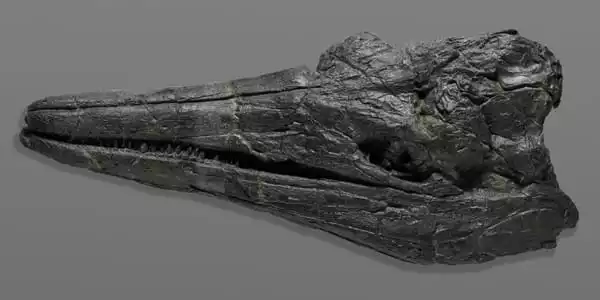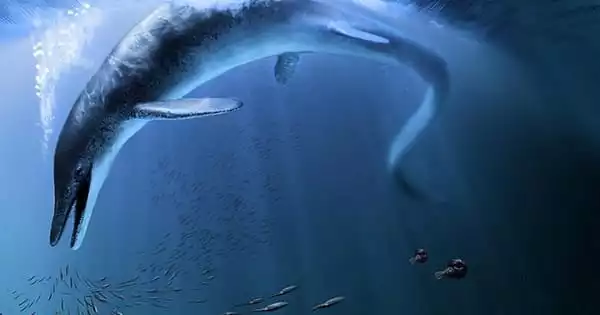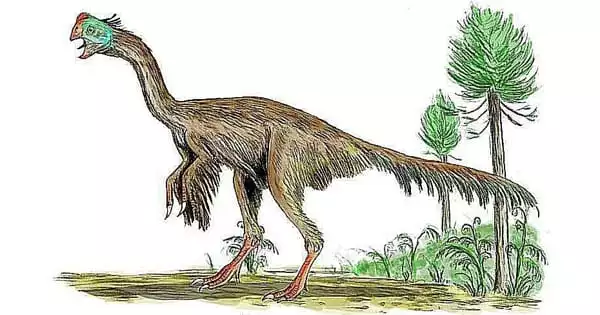The two-meter skull of an enormous new ichthyosaur species, Earth’s first known giant creature, reveals how extinct marine reptiles and modern whales evolved into giants. The two-meter skull of the earliest known species of giant ichthyosaur sheds new light on the marine reptiles’ rapid growth into behemoths of the Dinosaurian oceans, as well as helping us better understand the journey of modern cetaceans (whales and dolphins) to becoming the largest animals to ever inhabit the Earth.
While dinosaurs ruled the land, ichthyosaurs and other aquatic reptiles (which were not dinosaurs) ruled the seas, reaching similarly massive sizes and species diversity. Ichthyosaurs swam the ancient oceans for nearly the entire Age of Dinosaurs, with evolving fins and hydrodynamic body shapes seen in both fish and whales.
“Ichthyosaurs descended from an as-yet-unknown group of land-living reptiles that were air-breathing,” says lead author Dr. Martin Sander, a paleontologist at the University of Bonn and Research Associate at the Natural History Museum of Los Angeles County (NHM). “From the discovery of the first skeletons in southern England and Germany over 250 years ago, these ‘fish-saurians’ were among the first large fossil reptiles known to science, long before the dinosaurs, and they have captured the popular imagination ever since.”
The well-preserved skull, along with part of the backbone, shoulder, and forefin, was excavated from the Fossil Hill Member in Nevada’s Augusta Mountains and dates back to the Middle Triassic (247.2-237 million years ago), representing the earliest case of an ichthyosaur reaching epic proportions. At more than 17 meters (55.78 feet) long, the newly named Cymbospondylus youngorum is the largest animal discovered from that time period, either on land or in the sea. In fact, it was the first known giant creature to inhabit the Earth.
The densities of the largest ichthyosaurs from the Fossil Hill Fauna, including C. youngourum, must have been significantly lower than suggested by our field census due to their large size and resulting energy demands. The ecological functioning of this food web from ecological modeling was very exciting because modern highly productive primary producers were absent in Mesozoic food webs and were a major driver of whale size evolution.
Dr. Eva Maria Griebeler
“The significance of the discovery was not immediately apparent,” Dr. Sander explains, “because only a few vertebrae were exposed on the canyon’s side.” However, the anatomy of the vertebrae suggested that the animal’s front end was still hidden in the rocks. Then, on a cold September day in 2011, the crew needed a warm-up and put this theory to the test by excavating the skull, forelimbs, and chest region.”
The species’ new name, C. youngorum, honors a happy coincidence: the fieldwork was sponsored by Great Basin Brewery of Reno, which is owned and operated by Tom and Bonda Young, the creators of the locally famous Icky beer, which features an ichthyosaur on its label.
Paleontologists have been recovering fossils from the Fossil Hill Member’s limestone, shale, and siltstone in other Nevada mountain ranges since 1902, opening a window into the Triassic. The mountains connect our present to ancient oceans and have produced many ammonite species, shelled ancestors of modern cephalopods such as cuttlefish and octopuses, as well as marine reptiles. All of these animal specimens are known as the Fossil Hill Fauna, and they represent many of C. youngorum’s prey and competitors.
C. youngorum stalked the oceans 246 million years ago, or about three million years after the first ichthyosaurs got their fins wet, an incredibly short time to grow this large. C. youngorum’s elongated snout and conical teeth indicate that it hunted squid and fish, but its size suggests that it also hunted smaller and juvenile marine reptiles.
The colossal predator was most likely up against some formidable foes. The authors examined the likely energy running through the Fossil Hill Fauna’s food web using sophisticated computational modeling, recreating the ancient environment through data, and discovered that marine food webs could support a few more colossal meat-eating ichthyosaurs. Ichthyosaurs of various sizes and survival strategies proliferated, comparable to those of modern cetaceans, ranging from small dolphins to massive filter-feeding baleen whales and squid-hunting sperm whales.

Dr. Eva Maria Griebeler of the University of Mainz in Germany, a co-author and ecological modeler, says, “The densities of the largest ichthyosaurs from the Fossil Hill Fauna, including C. youngourum, must have been significantly lower than suggested by our field census due to their large size and resulting energy demands. The ecological functioning of this food web from ecological modeling was very exciting because modern highly productive primary producers were absent in Mesozoic food webs and were a major driver of whale size evolution.”
Whales and ichthyosaurs have more in common than just size. They have similar body plans and both arose following mass extinctions. Because of their similarities, they are scientifically valuable for comparative study. The researchers used computer modeling and traditional paleontology to investigate how these marine animals reached record-breaking sizes on their own.
“The integrative nature of our approach is one of the project’s most distinguishing features. We had to first describe the anatomy of the massive skull in detail and figure out how this animal is related to other ichthyosaurs” Dr. Lars Schmitz, Associate Professor of Biology at Scripps College and Dinosaur Institute Research Associate, is the senior author. “We didn’t stop there; we wanted to understand the significance of the new discovery in the context of the large-scale evolutionary pattern of ichthyosaur and whale body sizes, as well as how the Fossil Hill Fauna’s fossil ecosystem may have functioned. Both the evolutionary and ecological analyses necessitated a significant amount of computation, resulting in a convergence of modeling and traditional paleontology.”
They discovered that, while both cetaceans and ichthyosaurs evolved very large body sizes, their evolutionary paths toward gigantism were divergent. Ichthyosaurs experienced an initial growth in size, becoming giants early in their evolutionary history, whereas whales took much longer to reach the outer limits of huge. They discovered a link between large size and raptorial hunting (think of a sperm whale diving down to hunt giant squid) and a link between large size and tooth loss (think of the giant filter-feeding whales that are the largest animals ever to live on Earth).
The initial foray into gigantism of ichthyosaurs was most likely due to a surge in ammonites and jawless eel-like conodonts filling the ecological void left by the end-Permian mass extinction. While their evolutionary paths were different, both whales and ichthyosaurs relied on exploiting food chain niches to become extremely large.
“As scientists, we frequently discuss the similarities between ichthyosaurs and cetaceans, but we rarely delve into the specifics. This study stands out in one way because it allowed us to investigate and gain some additional insight into the evolution of body size in these groups of marine tetrapods “Dr. Jorge Velez-Juarbe, Associate Curator of Mammalogy (Marine Mammals) at the NHM. “Another fascinating aspect is that Cymbospondylus youngorum and the rest of the Fossil Hill Fauna are proof of the resilience of life in the oceans following the worst mass extinction in Earth’s history. This is the first major discovery of tetrapods in the oceans.”
C. youngorum will be kept permanently at the Natural History Museum of Los Angeles County, where it is now on display.
















